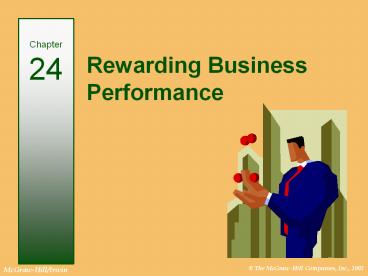Rewarding Business Performance - PowerPoint PPT Presentation
Title:
Rewarding Business Performance
Description:
Return on investment is the ratio of. profit to the average ... it would lower my pay! Criticisms of ROI. Gee . . . I thought we were. supposed to do what ... – PowerPoint PPT presentation
Number of Views:249
Avg rating:3.0/5.0
Title: Rewarding Business Performance
1
Chapter24
Rewarding Business Performance
2
Motivation and AligningGoals and Objectives
Goal Congruence Alignment of employeegoals and
objectiveswith organizationalgoals and
objectives.
3
Motivation and AligningGoals and Objectives
Measureperformance.
4
Return on Investment (ROI)
- Return on investment is the ratio ofprofit to
the average investment usedto generate the
profit.
5
Return on Investment (ROI)
Sales Average Investment
6
Return on Investment (ROI)
- Holly Company reports the following
- Profit 30,000
- Sales 500,000
- Average Investment 200,000
Lets calculate ROI.
7
Return on Investment (ROI)
8
Improving ROI
- Decrease Expenses
- Increase
- Sales Prices
- Lower
- Invested Capital
- Three ways to improve ROI
9
Improving ROI
- Hollys manager was able to increasesales
revenue to 600,000 whichincreased income to
42,000. - There was no change in invested capital.
Lets calculate the new ROI.
10
Improving ROI
11
Criticisms of ROI
- As division manager at Winston, Inc., your
compensation package includes a salary plus bonus
based on your divisions ROI -- the higher your
ROI, the bigger your bonus. - The company requires an ROI of 15 on all new
investments -- your division has been producing
an ROI of 30. - You have an opportunity to invest in a new
project that will produce an ROI of 25.
As division manager would you invest in this
project?
12
Criticisms of ROI
13
Residual Income
Operating Earnings Investment charge
Residual income
Investment capital Minimum return
Investment charge
Investment centersminimum acceptablereturn
14
Residual Income
- Flower Co. has an opportunity to invest 100,000
in a project that will earn 25,000. - Flower Co. has a 20 percent minimum acceptable
rate of return and a 30 percent ROI on existing
business.
Lets calculate residual income.
15
Residual Income
Operating Earnings 25,000 Investment
charge 20,000 Residual income 5,000
Investment capital 100,000 Minimum
return 20 Investment charge
20,000
Investment centersminimum acceptablereturn
16
Residual Income
- As a manager at Flower Co., would you invest the
100,000 if you were evaluated using residual
income? - Would your decision be different if you were
evaluated using ROI?
17
Residual Income
Residual income encourages managers to make
profitable investments that would be rejected by
managers using ROI.
18
Economic Value Added
Economic value added tells us how much
shareholder wealth is being created.
19
Economic Value Added
- Economic value added is the annual after-tax
operating profit minus the total annual cost of
capital. - Cost of capital is weighted-average
after-taxcost of long-term borrowing and the
cost of debt.
Debt
Equity
20
Residual Income
After-tax Operating Income Investment charge
Economic value added
(Total assets current liabilities)
Weighted-average cost of capital Investment
charge
After-tax cost oflong-term borrowingand the
cost of equity
21
Economic Value Added
- Economic value added can be improved in three
ways . . . - Increase profit without using more capital.
- Use less capital to earn the same amount of
profit. - Invest capital in high-return projects.
22
Balanced Scorecard
- A set of performance targets and results that
show an organizations performance in meeting its
responsibilities to various stakeholders.
Employee Stakeholder Group
Investor Stakeholder Group
23
Balanced Scorecard
Financial Perspective How do we lookto the
firms owners?
Vision and Strategy
Learning and Growth PerspectiveHow can we
continuallyimprove and create value?
Business ProcessPerspective In which activities
must we excel?
Customer Perspective How do our customers see us?
24
Components of Management Compensation
25
Design Choices for Management Compensation
Should we rewardcurrent performance orfuture
performance?
Should bonuses befixed or should theyvary with
aperformance measure?
Should teams ofemployees share bonusesequally
or should theybe in competition?
Should bonuses bebased on local
orcompany-wideperformance?
Should our rewards be based on
accountingnumbers or stock price performance?
26
End of Chapter 24
My performance was magnificent!































